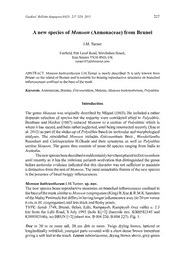
A new species of Monoon (Annonaceae) from Brunei PDF
Preview A new species of Monoon (Annonaceae) from Brunei
Gardens’Bulletin Singapore 65(2): 227-229. 2013 227 A new species of Monoon (Annonaceae) from Brunei LM. Turner Fairfield, Pett Level Road, Winchelsea Beaeh, East Sussex TN36 4ND, UK [email protected] ABSTRACT. Monoon bathrantherum LM.Turner is newly described. It is only known from Brunei on the island ofBorneo and is notable for bearing reproductive structures on branched inflorescences confined to the base ofthe trunk. Keywords. Annonaceae, Borneo, Enicosanthum, Malesia, Monoon bathrantherum, Polyalthia Introduction The genus Monoon was originally described by Miquel (1865). He included a rather disparate selection of species but the majority were considered allied to Polyalthia. Bentham and Hooker (1867) reduced Monoon to a section of Polyalthia which is where it has stayed, and been rather neglected, until being resurrected recently (Xue et al. 2012) as part of the shake-up ofPolyalthia based on molecular and morphological analyses. The remodelled Monoon includes Enicosanthum Becc., Woodiellantha Rauschert and Cleistopetalum H.Okada and their synonyms as well as Polyalthia section Monoon. The genus thus consists of some 60 species ranging from India to Australia. ThenewspeciesheredescribedwouldcertainlyhavebeenplacedmEnicosanthum until recently as it has the imbricate perianth aestivation that distinguished the genus before molecular evidence indicated that this character was not sufficient to maintain a distinction from the rest ofMonoon. The most remarkable feature ofthe new species is the presence ofbasal twiggy inflorescences. Monoon bathrantherum LM.Turner, sp. nov. The new species bears reproductive structures on branched inflorescences confined to & the base ofthe trunk similar to Monoon congregatum (King) B.Xue R.M.K.Saunders ofthe Malay Peninsula but differs in having longer inflorescence axes (to 20 cm versus 6 cm in M. congregatum) and less thick and fleshy petals. TYPE: Sands 5749, Brunei, Belait, Labi, Rampayoh, Rampayoh river valley c. 2.5 km from the Labi Road, 8 July 1993 (holo K[x2] (barcode nos. K000582145 and K000582146); iso BRUN [x2] (sheet nos. B 004 226, B 004 227). Fig. 1. m Tree to 20 or more tall, 20 cm dbh or more. Twigs drying brown, latticed or longitudinally wrinkled, youngest parts covered with a short dense brown tomentum giving a soft feel to the touch. Leaves subcoriaceous, drying brown above, grey-green 228 Gard. Bull. Singapore 65(2) 2013 «Ci^SOTAMCOdtaKXSKEW HERB.HORT.KEW. nERB.HORrKEW. ||'|ni|||||;||||| ROYALUTAWGLLAH^Cinit|n ^193V Sii£.Ej:J s-te^r-2 inir. Z^**.*!. BeliJl 4*2I'N)]4‘i7'C L*bi Ronpayoh-lUjiipayiAnvcrviJlc).c.2.Sk]nfioniUmLitii (o*d;c.lOOmiTTHnlh£river TlxtiubedLuwlini]DiptenKirr'FormLunbiifomuinn: UFiAfiiliAilfotmajluhIbtialeL/AdulalinsvtllByl>aor AltlTudp:3CMan) EnciIras2010iZtVindbli Oilerbi/t;trsy.imerhaikhulTmlhamlinnerline,s^i- W/ivt^hi:usnS.AAlki:iEDf.4i..NEi(J».CV^ilAfakyi.)kA«R(aWat(lefIAhckahLiuumlj,A'.bjLilah. wbnivcuodili.yrwlihtnhrisrlu]styCTliuumrt:;flloaiuvrcefMiidgi.iV««gUraeiesnivr|}hiucphaeidn iilvs4«ndrtuchtm. RoMfx;Crwaywhile. MJ.S.Sikn&5749 STTm Willi; S.AUira. EJ.Cowley, AHiirmg Ebnihim Abdullah. JengunnAkEn,NigaNahg^ARuiilnAkLuaag, VI FORES&TRDOEYPAALRTBMOhTlANNTICBRCUANREDIEDNASRKUESWSALAM Fig. 1. Photograph of Sands 5749, the holotype (mounted on two sheets) of Monoon bathrantherum I.M.Tumer. Reproduced with the kind permission ofthe Director and the Board © ofTrustees, Royal Botanic Gardens, Kew. Royal Botanic Gardens, Kew. below, some hairs along midrib, otherwise glabrous above, short hairs on midrib and major nerves below, lamina laneeolate to oblanceolate, 34-36 x 11-12 cm, lateral nerves, 21-24 pairs, arching forward and looping indistinctly near the margin, tertiary mm mm venation scalariform. Petiole c. 10 long, 4 in diameter, densely short brown hairy. Inflorescences ofrobust, much-branched leafless twigs, to at least 20 cm long, mm arising from the base of the main trunk. Flower pedicel to 6 cm long, 1.5 thick, drying brown, covered in a dense short brown tomentum, medial bract ovate, c. 7 x 3 mm, apex acute, covered in dense short tomentum abaxially, glabrous adaxially; flower n in bud broadly conical with a flat base, sepals valvate, chartaceous, ovate, c. 14 x mm, apex acute, densely covered in brown tomentum, outer petals imbricate in bud, ovate, c. 5-9 x 1.8-2 cm, dense, very short brown hairy outside with faint longitudinal lines, inside more sparsely hairy, inner petals slightly shorter and narrower than outer petals, centre oflongitudinal edges folded inwards to middle and apex incurved giving a hooded appearance to the distal portion, torus more or less flat with erect brown mm hairs, stamens many, c. 4 long, connective apex with white hairs, carpels many c. mm 4 long, brown hairy. Monocarps stipitate, ellipsoidal, c. 5 x 2 cm, beaked, dark brown hairy. NewMonoon species fromBrunei 229 Other specimens examined: BRUNEI DARUSSALAM. Belait. Labi, Mendaram, trail to Wasai Kadir, 4 Apr 1996, Said BRUN 16181 (BRUN: sheet no. B 004 229; K), Wong Kadir, trail to Wasai Wong Kadir, 15 Dec 1997, Ariffin & al. BRUN 18723 (BRUN: sheet no. B 004 230), Teraja, first waterfall, 28 Mar 2006, Mohd. Ariffin <& al. BRUN21689 (BRUN: sheet no. B 004 228). Etymology:. The specific epithet is derived from Greek: bathro- = basal, antheros = flower and reflects the basiflory exhibited by the species. Notes. Cauliflory is a relatively common feature in the Annonaceae, and occurs quite frequently in Monoon. The restriction of reproductive structures to the base of the trunk is a relatively rare phenomenon in trees but again it is found in the Annonaceae & and is observed in Monoon in species such as M. hypogaeum (King) B.Xue R.M.K.Saunders which also occurs in Borneo. Monoon hypogaeum is unlikely to be confused with M. hathrantherum as its inflorescences have long, slender, apparently flexible, axes compared to the relatively stout and stiff axes ofthe latter. The flowers of M. hypogaeum are smaller (petals to only 2 cm long) and the monocarps are distinctively fusiform. Vegetatively M. hathrantherum is like the Bornean M. erianthoides (Airy & Shaw) B.Xue R.M.K.Saunders, but the branched inflorescences and the stipitate monocarps (subsessile in M. erianthoides) readily distinguish it. ACKNOWLEDGEMENTS. Thanl^s to Jacqueline Heiirot (L) and Joffre b. Hj. Ali Ahmad (BRUN) for facilitating access to photographs of the material in BRUN. I.M. Turner is a ResearchAssociate ofthe Royal Botanic Gardens Kew and Singapore Botanic Gardens. References & Bentham, G. Hooker, J.D. (1867) Genera Plantanim. Volume 1, part 3. London: L. Reeve. Miquel, F.A.W. (1865) AnonaceaeArchipelagi hidici. Ann. Mus. Bot. Lugduno-Batavi 2: 1^5. & Xue, B., Su, Y.C.F., Thomas, D.C. Saunders, R.M.K. (2012) Pruning the polyphyletic genus Polyalthia (Amionaceae) and resurrecting the gQxms Monoon. Taxon 61: 1021-1039.
